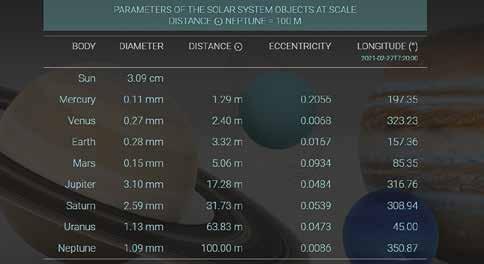
9 minute read
Service for Outreach
VOS4O: Virtual Observatory Solar System Scaling Service for Outreach
Benoit Carry
Advertisement
The Côte d’Azur Observatory (OCA) benoit.carry@oca.eu
Jérôme Berthier
Institute for Celestial Mechanics and Computation of Ephemerides (IMCCE) jerome.berthier@obspm.fr
Yohann Gominet
Institute for Celestial Mechanics and Computation of Ephemerides (IMCCE) yohann.gominet@obspm.fr
Keywords
solar system, scale model, web service, astronomy outreach
We present VOS4O, a simple and free web service aimed at helping the public create scale models of our Solar System. The user can set the scale, the diameter of the Sun or any planet, and the distance from the Sun to any planet. VOS4O then returns both a table with the numerical values and figures displaying the locations and sizes of the planets. The service allows customisation: users can choose the units of lengths, the language (12 are already available), and the epoch of display (useful for explaining planetary motion to, for example, elementary school kids). VOS4O proposes a web interface with a simple query form for most users. However, it is fundamentally a web service following the Virtual Observatory standards, and it can be easily integrated in a web page or software by querying its programming interface.
Introduction
What would the size of the Earth be if the Sun was a tennis ball? Or a soccer ball? How far away would Neptune be? These questions are more often than not asked by the public, kids, teachers and even local astronomers.
Knowing the true physical diameters of the Sun and the planets, and the semimajor axes of their orbits, the solutions to these questions are straightforward and only require a cross-multiplication. We present VOS4O which aims at providing these answers to the wider public through a web service, free of charge.
Furthermore, VOS4O allows users to more easily understand the real orbital dynamics of the Solar System. The question of scales in the Solar System is often raised to teach how immense space is compared to the sizes of the planets. Hence, planets are usually presented in alignment, creating a biased representation of our Solar System as the eight planets are never aligned in space. Building upon the ephemerides computation library of the Institute for Celestial Mechanics and Computation of Ephemerides (IMCCE)1, VOS4O thus presents users with the positions of the planets on their orbits (given as their ecliptic longitudes (Figure 1.a)), allowing users to easily understand the real orbital dynamics of the Solar System.
Typical Use Cases of VOS4O
We present here three examples of how people may use VOS4O: by setting a maximum size of a Solar System scale model, by using a common object as a reference for size, and to illustrate planetary motion. These three are common requests from primary school teachers.
Although scaling the Solar System is a simple cross-multiplication, users of VOS4O highly appreciated the ease of use and the graphical outputs with figures generated on the spot, ready for use in a classroom.
How Can I Put the Solar System in My Lecture Room? On My Patio?
Many schools or associations wish to build scale models of the Solar System on their premises. The natural question is therefore the size and distance of each planet from the Sun, knowing the maximum length available. VOS4O provides a direct answer by setting the distance of the furthest planet to the available length, for instance, 100 metres (Figure 1a). If the Sun Is a Basketball, Where Shall I Place the Earth?
A common approach to teaching scales is to present a round object to students, setting the size of the Sun, and then asking for the corresponding size and distance of the Earth (or any other planet). VOS4O offers an easy way to get the answer by setting the diameter of the Sun or any planet (Figure 1b).
How Do Planets Move?
Understanding the motion of planets, and in particular the large difference of orbital periods, is non-trivial for children at the primary school level. VOS4O allows users to input a set date and receive the positions of planets along their orbit with a view of the Solar System (Figure 1c). Displaying several results from VOS4O at different epochs offers a convenient way to illustrate planetary motion to the public.
We note from experience, that one of the key points in the VOS4O is its “numerical” output of the ecliptic latitude. We have seen educators preparing markings on the ground and placing children on the markers at “different epochs” so they reenact the planet’s motion, rather than to experiencing it only visually. The children roleplaying Neptune won’t barely move
Figure 1. Three charts built by VOS4O. a) (top) Chart describing the distance between objects in the Solar System if Neptune was 100 metres from the Sun. b) (center) A chart of the Solar System showing the relative diameters and distances of the planets if the Sun was 24 centimetres in diameter. c) (bottom) View of the Solar System showing the position of the planets. Credit: University of Côte d’Azur/Côte d’Azur Observatory /Institute for Celestial Mechanics and Computation of Ephemerides/Paris Observatory/ CNRS.
while the children representing Mercury or Venus will move rapidly.
Access and Results
Most users will access VOS4O through its web pages2. A minimalist form allows users to set the scale and unit (Figure 2). Upon clicking the ‘Apply’ button, the interface creates a table of values and figures, and displays them in the browser. Users can directly download them; a download interface is provided for users to choose the formats of both the data and figures (‘Download results’ button).
The data can be retrieved in plain text, CSV, or VOTable, the native XML format of the Virtual Observatory (VO). The figures are provided in PNG, TIFF, PDF, and SVG formats.
More advanced parameters allow users to compute the position of the planets for a specific date and to adjust scaling relative to the diameter of a chosen planet.
VOS4O follows the standard data formats of the VO, a concept widely used in astronomy whose cornerstone is that astronomical datasets and other resources should work as a seamless whole3. As such, VOS4O can be directly queried via its application programming interface (API), which allows anyone to set up their own software to directly interrogate the service and retrieve the tables and images generated, or to create their own web form to scale the Solar System.
VOS4O is currently available in 12 languages. It is configured to display the default language of the web browser used to access it. The table and figures can however be set to another language from the advanced parameters form, or the entire web page can be switched to another language from a drop-down
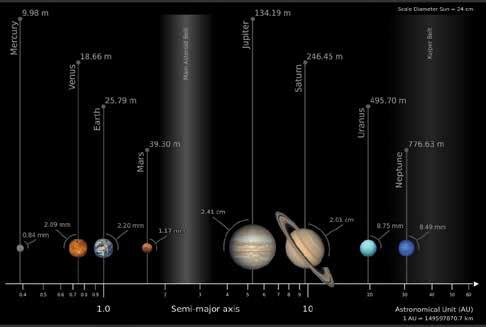
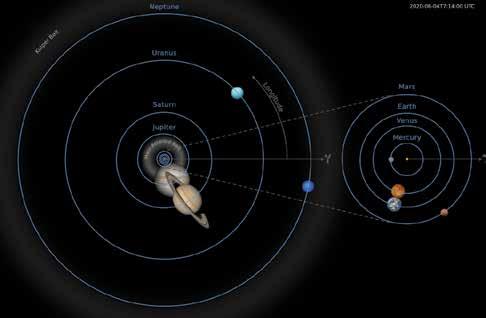
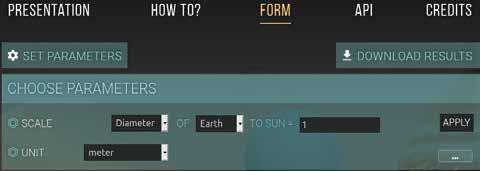
Figure 2. The native form of VOS4O, developed to the needs of general users. Credit: University of Côte d’Azur/ Côte d’Azur Observatory /Institute for Celestial Mechanics and Computation of Ephemerides/Paris Observatory/ CNRS.
menu. We plan to offer more languages in the future4 .
Lessons Learnt
The development of VOS4O presented strong differences with our previous experience creating web services: the target audience was no longer professional astronomers and engineers, accustomed to machine-machine interaction, but the general public, accustomed to an easy-touse, graphically attractive, and multilingual interface.
We thus designed VOS4O in two parts. The core of the service, which performs the ephemeris computations, is composed of a genuine web service allowing machinemachine interactions. This is fundamental to guarantee the durability and versatility of the service, beyond a simple spreadsheet or static web page. Moreover this allows independent integration of the service in third-party software or applications. The core is then coated with a graphical layout, designed to be attractive, easy to use, and multilingual to ensure the effective interaction with the public, whether children or adults, teachers or students. Now produced in Javascript, the graphical user interface will be easy to update in the future to follow the evolution of web technology.
Final Considerations
This article represents the official release of VOS4O, an outreach web service to represent the Solar System at any scale. We have received very positive feedback from the relatives, teachers, parents, and professional and amateur astronomers who have already used the service. While scaling the Solar System only requires cross-multiplications, the interface was found ergonomic and intuitive. Users praised the figures generated by the service for displaying all the information needed to describe or build a scale model. In particular, users have appreciated that the figures show the real locations of the eight planets, a unique feature among scaling web pages to our knowledge.
We will keep adding new languages to the service. We hope VOS4O will be widely used by a large audience all around the globe.
Notes
1 Online ephemerides from the IMCCE: https://ssp.imcce.fr/forms 2 VOS4O websites: https://vos4o.imcce.fr and https://vos4o.oca.eu 3 More information about the Virtual Observatory can be found on the International Virtual Observatory Alliance: https://www.ivoa. net/ 4 We always welcome volunteer translators for this work. Contact vo.imcce@obspm.fr for more information.
Acknowledgements
We thank everyone who has translated VOS4O in its many languages: Simplified Chinese (S.X. Gong and Y. Zhang, OCA), English (J. Berthier, IMCCE, and B. Carry, OCA), French (J. Berthier, IMCCE and B. Carry, OCA), German (M. Schultheis, OCA), Greek (G. Kordopatis, OCA), Hindi (G. Nandakumar, RSAA), Italian (F. Spoto, OCA), Polish (D. Oszkiewicz, AMU), Portuguese (J. Ferreira, OCA), Romanian (M. Birlan, IMCCE), Spanish (C. Piñero and B. Carry, OCA), and Suomi (M. Pöntinen, HY).
Biographies
Benoit Carry is an astronomer at the Côte d’Azur Observatory (OCA) in Nice, France. He studies the surface composition and physical properties of asteroids. He teaches at the local university and often presents to amateur astronomical societies and to children from primary to high school. The idea of VOS4O emerged during one of these encounters in a primary school in Nice.
Jérôme Berthier is a scientific-computing engineer at the Institute for Celestial Mechanics and Computation of Ephemerides (IMCCE) at the Paris Observatory, France. He is the main developer of the library that computes and disseminates ephemerides with Virtual Observatory standards at IMCCE. The web services he developed and maintains are used more than 30,000 times each day.
Yohann Gominet is a computer graphic and web designer at the Institute for Celestial Mechanics and Computation of Ephemerides (IMCCE) at the Paris Observatory, France. He is responsible for designing and implementing the publication of ephemerides developed at IMCCE. His main professional activities are editorial work, graphic media, and website design and development.
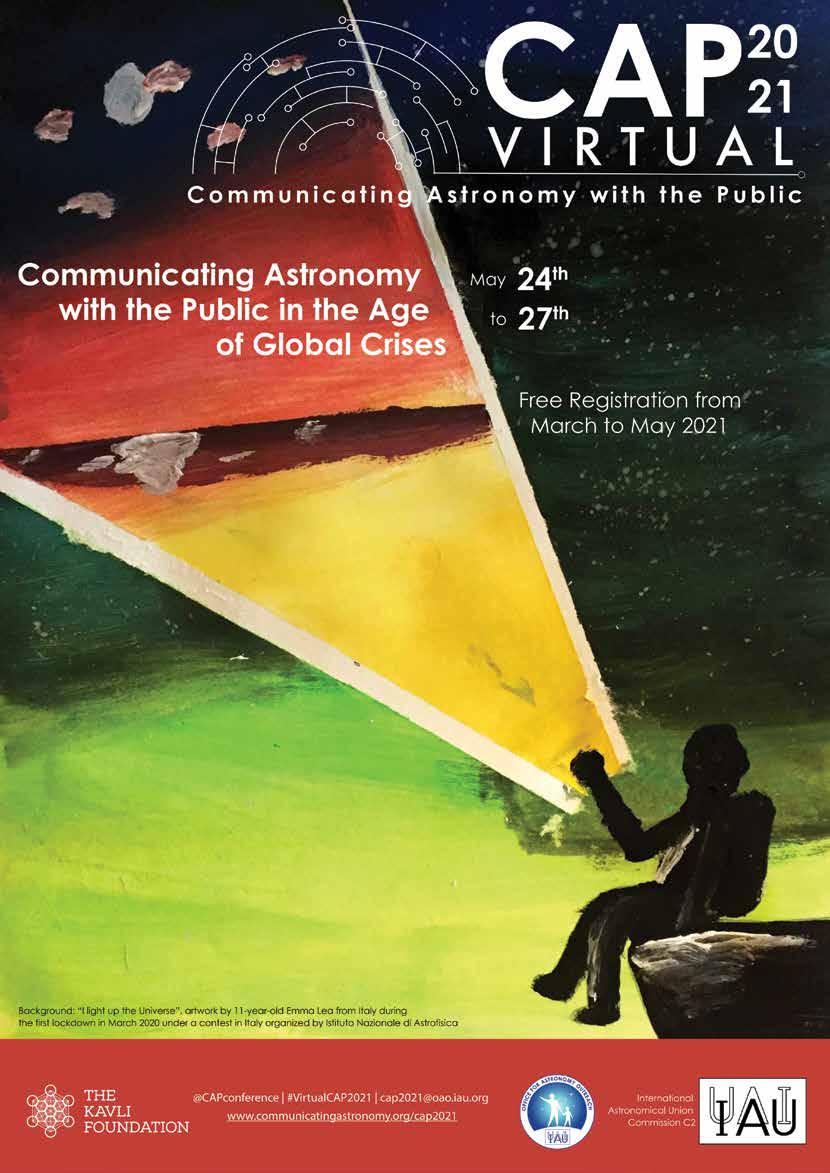
Colophon
Editor-in-Chief
Lina Canas
Managing Editor
Lina Canas
Executive Editor
Hidehiko Agata
Copyeditor Izumi Hansen
Layout and Production
Lina Canas Makiko Aoki
Contributors
Aditya Abdilah Yusuf Anna Glushko Benoit Carry Bill McDonald Carla Fuentes-Muñoz Constance E. Walker Georgia Bracey Houston Southard Jean Pierre Grootaerd Jérôme Berthier Justine Breedon Smith Lina Canas Maya Bakerman Muchammad Toyib Nicole Gugliucci Oana Sandu Pamela L Gay Pamela Paredes-Sabando Ramasamy Venugopal Richard Fienberg Sanlyn Buxner Sarah Burcher Yohann Gominet
Editorial Board and Peer Reviewers
Amelia Ortiz-Gil April Whitt Avivah Yamani Kimberly Kowal Arcand Kumiko Usuda-Sato Michelle Willebrands Ramasamy Venugopal Richard Fienberg
Web Design and Development
Raquel Shida Gurvan Bazin
journal
Address
CAPjournal, IAU Office for Astronomy Outreach, C/O National Astronomical Observatory of Japan 2-21-1 Osawa, Mitaka, Tokyo, 181-8588 Japan
editor@capjournal.org
Website
www.capjournal.org
ISSNs
1996-5621 (Print) | 1996-563X (Web)
License
This work is licensed under a Creative Commons License
Communicating Astronomy with the Public
Submission
We are keen to encourage readers to submit their own articles, reviews, and other content.
Submissions should be sent to the Editor: editor@capjournal.org
Publishers Sponsors
www.capjournal.org
Online issues Free subscriptions Article submission






